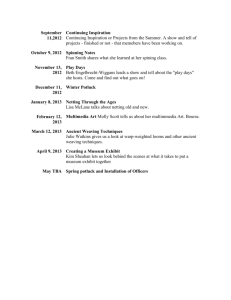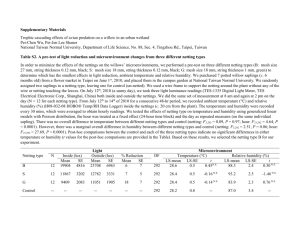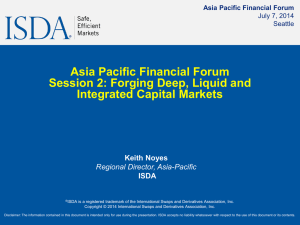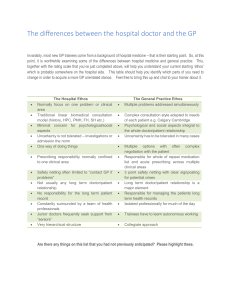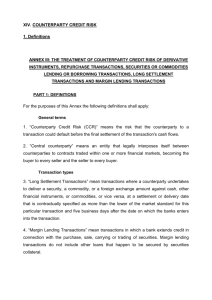Overarching principles applied in the development of the proposed
advertisement
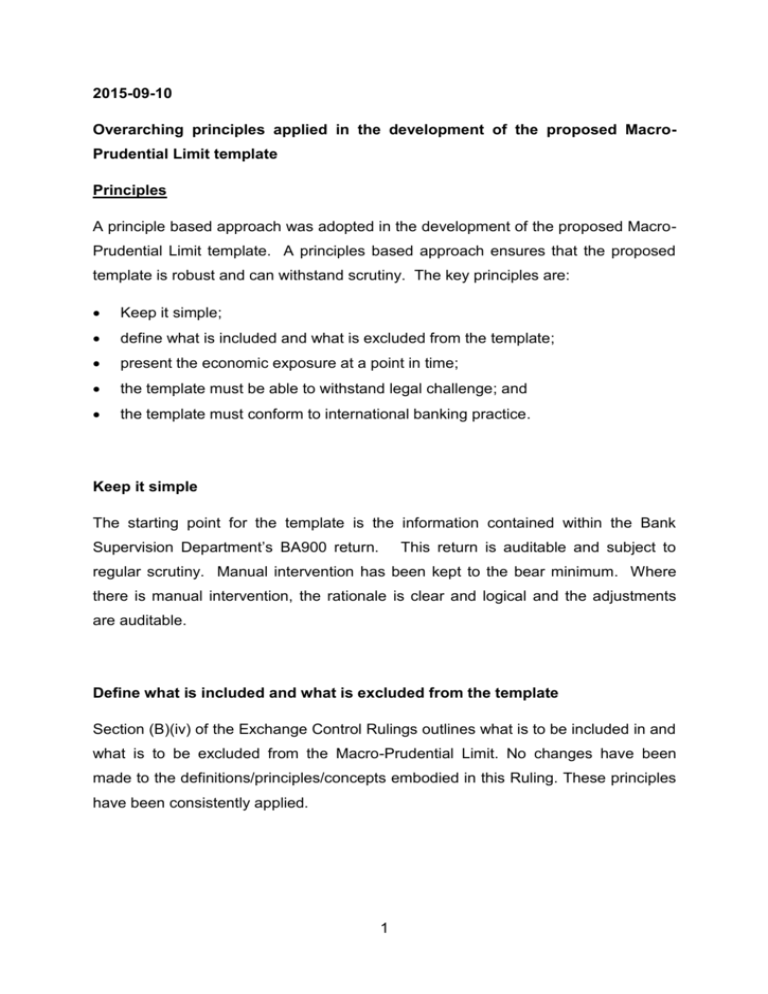
2015-09-10 Overarching principles applied in the development of the proposed MacroPrudential Limit template Principles A principle based approach was adopted in the development of the proposed MacroPrudential Limit template. A principles based approach ensures that the proposed template is robust and can withstand scrutiny. The key principles are: Keep it simple; define what is included and what is excluded from the template; present the economic exposure at a point in time; the template must be able to withstand legal challenge; and the template must conform to international banking practice. Keep it simple The starting point for the template is the information contained within the Bank Supervision Department’s BA900 return. This return is auditable and subject to regular scrutiny. Manual intervention has been kept to the bear minimum. Where there is manual intervention, the rationale is clear and logical and the adjustments are auditable. Define what is included and what is excluded from the template Section (B)(iv) of the Exchange Control Rulings outlines what is to be included in and what is to be excluded from the Macro-Prudential Limit. No changes have been made to the definitions/principles/concepts embodied in this Ruling. These principles have been consistently applied. 1 Present the economic exposure at a point in time Both the existing and proposed Macro-Prudential Limit templates present the economic exposure at a point in time, i.e. month end. Neither the existing or proposed templates show potential future exposures. Potential future exposures are addressed in the risk and capital returns. These principles have been consistently applied. The template must be able to withstand legal challenge The proposed template is predominantly principle based. Where required (i.e. derivatives), signed legal contracts are in place and legal opinions are obtained to ensure that courts in the jurisdictions of both counterparties would recognise the enforceability of the netting agreements The template must conform to international banking practice Current market principles of net settlement as opposed to gross settlement in event of default have been adopted. Further information is detailed below. Application of bilateral netting Careful consideration has been given to the issue of bilateral netting of master netting arrangements i.e. including the net rather than the gross claims with the same counterparties arising out of the full range of OTC forwards, swaps, options and similar derivative contracts. Accordingly, in relation specifically to OTC derivative contracts it has been agreed for macro-prudential limit purposes that: a) Authorised Dealers may net transactions subject to novation under which any obligation between an Authorised Dealer and its counterparty to deliver a given currency on a given value date is automatically amalgamated with all other 2 obligations for the same currency and value date, legally substituting one single amount for the previous gross obligations. b) Authorised Dealers may also net transactions subject to any legally valid form of bilateral netting not covered in (a), including other forms of novation. c) In both cases (a) and (b), an Authorised Dealer shall have in place: I. A netting contract or agreement with the counterparty which creates a single legal obligation, covering all included transactions, such that the Authorised Dealer would have either a claim to receive or obligation to pay only the net sum of the positive and negative mark-to-market values of included individual OTC derivative transactions in the event a counterparty fails to perform due to any of the following: default, bankruptcy, liquidation or similar circumstances; II. Written and reasoned legal opinions confirming that, in the event of a legal challenge, the relevant courts and administrative authorities would find the Authorised Dealer's exposure to be such a net amount under: The law of the jurisdiction in which the counterparty is chartered and, if the foreign branch of a counterparty is involved, then also under the law of the jurisdiction in which the branch is located; the law that governs the individual transactions; and the law that governs any contract or agreement necessary to effect the netting. The Financial Surveillance Department, after consultation with other relevant supervisors and regulators, should be satisfied that the netting is enforceable under the laws of each of the relevant jurisdictions. Thus, if any of these supervisors or regulators are dissatisfied about enforceability under its laws, the netting contract or agreement will not meet this condition and hence netting will not be allowed. 3 III. Robust procedures to ensure that the legal characteristics of netting arrangements are kept under review in the light of possible changes in relevant law. d) Contracts containing walkaway clauses will not be eligible for netting for the purpose of calculating the Macro-Prudential Limit. A walkaway clause is a provision which permits a non-defaulting counterparty to make only limited payments, or no payment at all, to the estate of a defaulter, even if the defaulter is a net creditor. Source data and manual adjustments The source of the figures is given on the face of the template, where the numbers were sourced from another recognised return. To the extent that manual intervention is required a detailed explanation of adjustment is set out below. Line Explanation 2a Commodities together with other investments are included in line 241 of the BA 900. The total commodities asset balance is split between column 1 (domestic) and column 2 (foreign) depending on the domicilium of the counterpart to the trade. The regulations relating to NOFP and Circular 6/2010 deem all commodities to be foreign. Line 2a on the MPL return removes that portion of the total commodities balance that is disclosed as foreign in the BA 900 line 241 as the entire commodities balance is included in line 2b. Line 2a seeks to prevent the double count. 2b This line references the total commodities balance as per line 29 of the BA 100, on the basis that all commodities are deemed to be foreign. 4 2c Foreign exposures directly related to outward foreign direct investment in subsidiaries, including acquisitions in terms of Section 52 of the Banks Act, 1990, (Act No. 94 of 1990), are included as foreign exposures in line 217 of the BA 900. Ruling B.2(B)(iv) specifically excludes these exposures from the MPL calculation. Line 2c thus reduces the total on-balance sheet exposure by the amount of the equity investment in foreign subsidiaries. 2d Foreign exposures directly related to outward foreign direct investment in associates and joint ventures, including acquisitions in terms of Section 52 of the Banks Act, 1990, (Act No. 94 of 1990), are included as foreign exposures in line 221 of the BA 900. Ruling B.2(B)(iv) specifically excludes these exposures from the MPL calculation. Line 2d thus reduces the total on- balance sheet exposure by the amount of the equity investment in foreign associates and joint ventures. 2e Intra group bank exposures are included as part of the total on balance sheet exposures reported on line 277 of the BA 900. Ruling B.2(B)(iv) states that intra group bank exposures are excluded from the MPL. Intra group bank exposures are contained within various different lines in the BA 900. As intra group exposures are not separately identified, these exposures must be adjusted for from the underlying data. 2f Ruling B.2(B)(iv) states that Authorised Dealers must note that where advances are made available to their offshore branches/subsidiaries and such funding is externalised to third party clients, funding so utilised, should be included in the calculation of the macro-prudential limit. Funds externalised indirectly through a branch/subsidiary in this manner are deemed as funds being made available directly by the Authorised Dealer to the offshore third party. This line refers to the NET OUTFLOW with a minimum limit of zero. 5 2g The modern financial market, has developed new approaches able to reduce market participants’ credit risk exposure, amongst them netting arrangements, i.e. the contractual arrangement between counterparties to apply netting in respect of their mutual rights and obligations In terms of internationally accepted banking practice, where a bank has a legally enforceable netting agreement in place, the bank may net off current positive market values against current negative market values in order to calculate a single net current exposure for all transactions covered by the said netting agreement. The resultant net replacement cost (or current market value) being subject to a minimum value of zero. This principle only takes cognisance of the current exposure component in estimating Exposure At Default (“EAD”) i.e. the Current Market Value (“CMV”) For the purposes of the Macro Prudential Limit template, derivative netting is based on: signed ISDA agreements which; o permit netting in the event of default; o across product types; o across currencies; o across maturities; o collateral arrangements; o per legal entity (except FI branches where Branch ISDA agreements are signed); and legal opinions to ensure that courts in the jurisdictions of both counterparties would recognise the enforceability of the netting agreement. Close-out netting is a process intended to reduce exposures on open contracts if one party should become insolvent or trigger a default like event before the settlement date. The netting agreement typically provides that, on an event of default in relation to one party, the other party can terminate all outstanding contracts between the parties, calculate the losses and gains on each contract and then set them off so that only a balance is owing. These 6 losses and gains are usually the difference between the agreed price of each transaction concerned and the market price at termination. These contracts are routine in financial markets and elsewhere. Upon close-out, all unperformed contracts are terminated and the market value of each contract is determined under a pre-defined valuation mechanism. The aggregate value of all contracts is then computed so as to result in one single payment obligation. This obligation remains the only obligation to be settled and is generally due immediately after the net amount is determined. The net exposure in the event of default of the counterparty is often only a small fraction of the gross exposure. The Bank for International Settlements provides data illustrating the effect of close-out netting. The notional amount of all types of OTC contracts stood at approximately USD 605 trillion at the end of June 2009. The gross market value of these contracts was USD 25 trillion. This amount corresponds to the market risk inherent in these contracts. The remaining credit risk taking into account legally enforceable netting agreements amounted to USD 3.7 trillion, which represents a risk reduction of 85% of the gross market value. Regulatory authorities (most recently, the Cross-border Bank Resolution Group of the Basel Committee on Banking Supervision) encourage the use of such netting arrangements because of their beneficial effects on the stability of the financial system. For cross-border use, the International Swaps and Derivatives Association (ISDA) Master Agreement is the quasi standard for derivatives transactions from the world-wide perspective, whereas repurchase agreements are usually bundled under the ISMA Global Master Repurchase Agreement which is the market-standard document used for trading repos in in the international repurchase (repo) agreement markets; in Europe, the multi-product European Master Agreement for Financial Transactions (EMA) of the European Banking Federation is widely applied. 7 ISDA regularly updates a list of countries that have adopted netting and collateral legislation on its website (www.isda.org>opinion and legislation>Netting legislation status). These countries are: Andorra; Anguilla; Australia; Austria; Belgium; Brazil; British Virgin Islands; Canada; Colombia; Czech Republic; Denmark; Finland; France; Germany; Greece; Hungary; Ireland; Israel; Italy; Japan; Luxembourg; Malta; Mauritius; Mexico; New Zealand; Norway; Peru; Poland; Portugal; Romania; Russia; Slovakia; Slovenia; South Africa; South Korea; Spain; Sweden; Switzerland; United Kingdom; and United States. Netting legislation is currently under consideration in Argentina; Chile; Pakistan; and Seychelles. There needs to be certainty that courts in the jurisdictions of both counterparties would recognise the enforceability of the close-out netting agreement. Banks commission legal opinions to assess the enforceability. The law in South Africa takes an approach of statutory insolvency netting, following which all unperformed obligations arising out of one or more master agreements between the parties shall, upon opening of an insolvency proceeding of a South African domiciled party to such agreement, terminate automatically on the date of the opening of the proceeding. The values of those obligations must be calculated at market value as at that date, the values so calculated must be netted and the net amount is be payable. Section 35B. paragraph 1 Insolvency Act (24 of 1936). 2h Collateral placed for derivative credit mitigation further reduces the risk and thus should be deducted to better reflect the economic exposure. 2i Foreign exposures as a result of reverse repurchase agreements are included as part of line 1 of this template. To the extent that reverse repurchase agreements with non-resident counterparts are collateralised/ reference South African assets, they should be excluded from the foreign exposures as the underlying asset is domestic. 8 4a Off balance sheet exposures reported in lines 285 to 293 include domestic and foreign counterparts. The deduction included in line 4a of the MPL template is to remove the exposures to South African counterparts, leaving the residual, foreign off balance sheet exposure. 4b The current market value of credit derivatives is included in line 1 of this template. The notional value of these credit derivatives is disclosed on L290 as an off balance sheet item. This must be adjusted for in order to reflect the economic exposure included in line 1 of this template and avoid a double count. 4c No capital is held on uncommitted, undrawn facilities as there is no exposure. As such, this should be excluded. 7a The derivative netting applied in line 2g above to reduce the foreign asset exposure, should be deducted from the total liability balance. 7b Similar to the adjustment in line 7a, where intragroup bank exposures are included in line 2f (affecting the numerator), these should be removed from the denominator. 9
